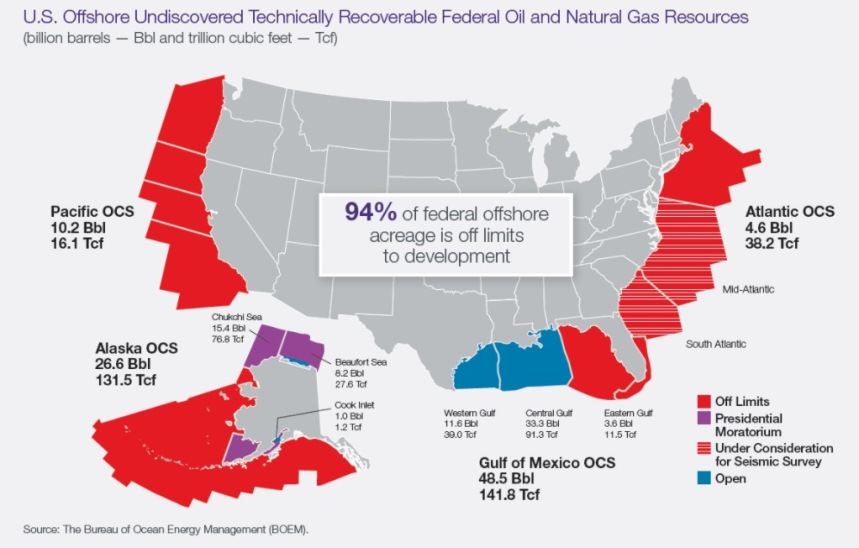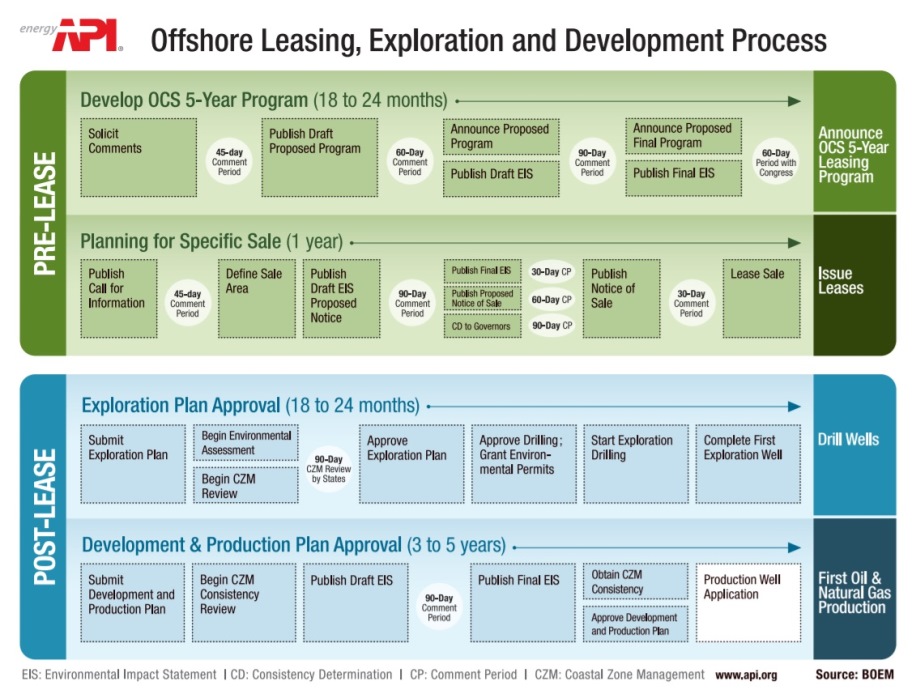Offshore 101: Energy for America’s Future Security
Mark Green
Posted December 11, 2017
Soon, the Interior Department is expected to release its draft offshore leasing program that will shape natural gas and oil development on the federal outer continental shelf (OCS) for the next five years, 2019-2024. Recognizing that the leasing program only outlines where lease auctions could be conducted, let’s take a look at some offshore basics to provide full context to a process that’s critically important to our country’s future energy security.
Our Vast Offshore Potential
Right now, about 94 percent of offshore acreage under federal control is off limits to natural gas and oil development:

The Bureau of Ocean Energy Management (BOEM) estimates that 89.9 billion barrels of oil and 327.5 trillion cubic feet of natural gas could be discovered and developed on the OCS – energy that’s important for our country’s sustained energy security, as well as our national security. The United States is one of the few nations that in recent years has not worked to fully harness its offshore natural gas and oil potential.
Offshore Energy Means Thinking Strategically
The entire process to develop natural gas and oil offshore can take seven or more years – when you count formulation of the federal leasing plan, exploration, development and actual production. Here’s a diagram:

That’s a long timeline. Decisions made today affect offshore energy production well into the future. Think of it this way: Much of our current offshore natural gas and oil production is the result of lease sales, exploration and production processes set in motion at the outset of the Obama administration – the first one.
Keep Options On the Table
The leasing program is a blueprint, a mapping out of potential options. Including an area in the program – for example, the Mid-Atlantic OCS – only means that the government has the option to schedule a lease auction in that area sometime over the program’s five-year duration. Actual lease purchases by natural gas and oil companies, followed by exploration and development, would depend on favorable resource analysis, economics and other factors.
Conversely, omitting an area from the federal program removes it as an option for development during the plan’s five years. The sound path for the future energy security of the United States is to maximize the available options for future development through a robust, forward-thinking leasing program.
Needed: Up-to-Date Resource Information
Before a company bids on a lease, it must have up-to-date, accurate geologic data showing that natural gas and/or oil may be found in a specific leasing block. The location and size of these potential resources is pinpointed through advanced, safe seismic testing.
The investments needed to develop offshore energy are significant, and companies need scientific analysis of current data to proceed. Take the Atlantic OCS from New Jersey to Florida: The last surveys of that area were conducted more than 30 years ago. Given technological advances, existing estimates – that the Atlantic OCS could hold about 4.6 billion barrels of oil and approximately 38 trillion cubic feet of natural gas – need updating.
Seismic testing is well-regulated to optimize safety for marine life. The technology is advanced, and a rigorous permitting process ensures that seismic operators will conduct surveys safely and efficiently. For example, during a ramp-up stage, sound levels are gradually increased so animals can leave the area. Also, trained marine mammal observers are positioned onboard surveying vessels and can order that testing be shut down. Here’s a short video with more details:
Safety is a Core Value
The natural gas and oil industry has the experience and advanced technology to safely develop the nation’s offshore reserves. Industry and regulators have worked together to make offshore development safer than ever – to protect workers, the environment, wildlife and coastal communities.
Since 2010, more than 100 exploration and production industry standards were created or strengthened – standards for safety and environmental management, well design, blowout prevention and spill response. The federal Bureau of Safety and Environmental Enforcement references 96 API standards in its offshore regulations.
The Center for Offshore Safety was created by industry to promote the highest levels of safety by adopting standards of excellence, helping offshore operators develop safety and environmental management systems, sharing information, compiling and analyzing key safety performance metrics and more.
Safety technology and response capabilities include advanced well containment systems and response equipment. Here’s a video that details incident response solutions:
Private Investment, Broad Public Benefits
Opening offshore areas, such as the Atlantic and Eastern Gulf of Mexico, could create thousands of U.S. jobs and help growth local, state and national economies. For example, a study a few years ago projected that tens of thousands of jobs could be supported in three Atlantic Coast states by offshore energy activity.
Offshore development is privately funded by natural gas and oil companies, which pay the federal government for leases, as well as royalty payments when actual production begins.
API supports revenue-sharing agreements for coastal states hosting natural gas and oil development off their shores, to ensure those states receive a fair share of revenues collected by the federal government from companies that are engaged in offshore development.
Again, the outer continental shelf holds strategic reserves of natural gas and oil that would be significant for the U.S. economy and our nation’s security in the world. Developing offshore reserves requires years of planning, resource analysis and exploration before actual production begins. Because access to reserves is foundational for significant energy production the United States will need a decade or two in the future, sound decisions are needed today for that energy tomorrow.
About The Author
Mark Green joined API after a career in newspaper journalism, including 16 years as national editorial writer for The Oklahoman in the paper’s Washington bureau. Previously, Mark was a reporter, copy editor and sports editor at an assortment of newspapers. He earned his journalism degree from the University of Oklahoma and master’s in journalism and public affairs from American University. He and his wife Pamela have two grown children and six grandchildren.


